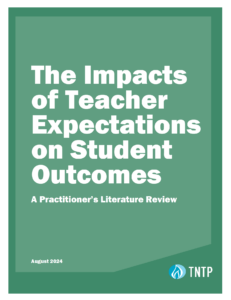On Tuesday, I joined my colleagues in Washington, D.C. to launch our new report, The Mirage: Confronting the Hard Truth About Our Quest for Teacher Development.
It was exciting to finally share this report—which has been in the works for two years—with the world. If you haven’t read it yet, you can do so here, or check out Dan Weisberg’s recap of the major findings. The bottom line is that school districts are making huge and laudable investments in teacher development, yet most of our help isn’t all that helpful in improving teacher practice.
Now that The Mirage is out in the world, I know people are going to react to it, and that not all of those reactions will be positive. Even for us at TNTP, the findings have been sobering.
As TNTP’s president, I lead our client services, including our teacher training and development work. Improving teacher practice is a mission that is at the heart of our work as an organization. It’s deeply personal for me, too; it’s why I’ve worked in education for 25 years—as a teacher, principal, and as a leader of teacher training, first at Teach For America and now here at TNTP.
So coming to terms with these findings has been, in some ways, tough for me. Processing The Mirage has been a little like the five stages of grief: first, there was denial (no—this methodology must be wrong!how dare you say our work isn’t helpful? How is this report helpful?it’s all hopeless; should we just scrap all of our work?maybe if we just tried this other professional development approach, in this improved way?) and finally, acceptance. This isn’t what we wanted to hear, but we can learn from it—and we might need to hear it to really make a difference.
I’ve had time to get to acceptance now, so I can appreciate how readers may be experiencing this report, and want folks to have their own emotional responses to these findings, chew on them, and consider where we go from here. Because in fact, there are takeaways from The Mirage that can help us think about teacher development in new and potentially more effective ways. After all, we didn’t find that teachers aren’t growing at all—we found improvers in 95 percent of the schools we studied. And despite its small sample size, the charter management organization we studied generated positive data that point to some promising strategies for how more school systems can create the conditions that foster continuous teacher improvement.
Teachers in the CMO grew notably more than their counterparts in the districts we studied: seven out of 10 CMO teachers showed substantial growth in performance, compared to three out of 10 district teachers. The CMO seems to have established a clear bar for quality, made that bar visible to teachers (in part through frequent feedback and opportunities to practice their craft), and created a culture where continuous improvement is the expectation. And teachers seem to have internalized that—more than 80 percent of CMO teachers agree they have weaknesses in their instruction, compared to less than 50 percent of district teachers.
The CMO doesn’t offer a silver bullet answer, as teacher growth there was still limited. But the average level of teacher and student performance in their schools was substantially better than in the districts we studied. It suggests there’s value in a culture that places development front and center and sets a clear, high bar for quality.
So what does all this mean for our work at TNTP? We’re having to take a step back and ensure that our findings are infused into our approach. This isn’t easy, believe me, as we partner with many clients to help them improve new and veteran teacher performance.
As we move forward, The Mirage is pushing us to think more critically about how we measure the impact of these development initiatives. We’re starting to think in more detail about the effectiveness of our interventions, too; for example, our Fast Start training, which focuses on helping new teachers acquire foundational teaching skills through practice and feedback, might be very good at preparing teachers to have a classroom culture that has high expectations for behavior and academics. But it may be less effective at preparing teachers to teach rigorous content. That doesn’t mean we need to throw the baby out with the bathwater, but it does mean we need to be more diligent about making sure our clients—principals and district leaders—understand what the Fast Start training can help with, rather than expecting Fast Start to address all instructional challenges. We will continue to measure the impact of our programs on teacher performance and to refine our approaches based on results.
Given that we are investing so much in current teacher development efforts with only modest progress, we’re also thinking more broadly about what we can do to dramatically improve student achievement. Perhaps we should be investing more in other strategies to improve the quality of classroom instruction, like innovations in school design and restructuring the teacher job into new, more specialized roles. I will always believe teacher development is a worthy investment of time and money; like all professionals, teachers need to feel like they are growing and learning. But to get to the improved student outcomes that we aspire to, we also need to invest in other strategies.
All of this leaves me both anxious and hopeful about the work to come. One thing is certain: There isn’t going to be a quick fix to the challenge of teacher improvement. But we’ll never achieve our goal of great teaching for every child if we don’t have the tough—and productive—conversations about what we can all do better.








